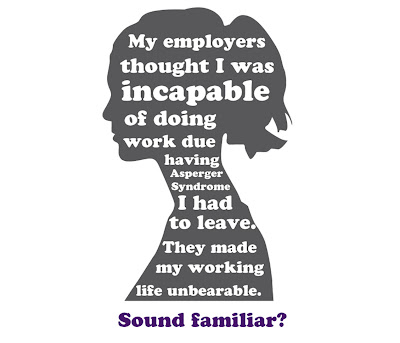In order to raise awareness of Asperger Syndrome in adults I decided that at this stage in my ideas, my work needs to answer the following questions about Asperger Syndrome to influence the posters:
1. What is Asperger Syndrome? 2. How would I know if I had Asperger Syndrome? 3. How would I know if my friend/relative had AS?
I asked an adult with AS these questions and began some initial typographic explorations surrounding one of the responses:
Monday, 25 July 2011
Pause
I previously did a variety of sketchbook ideas that explored the relationship between imagery and text. However, I began to realise that the imagery often drew away from the stories that the pieces were trying to convey and the core aim i.e. making people aware of Asperger Syndrome in adults, was also getting lost in translation. After analysing the concept (see below), I decided to take a clearer approach by using typography.
Catch up - Sketchbook work
The past couple of weeks I have been continuing with my campaign ideas that will hopefully aid me with raising awareness of Asperger Syndrome in adults. I am still focusing on the relationship between the person and the words they speak or don't speak and the stories they carry inside. See below for sketch book ideas. Please not that 'black lines' represent the area where the text could feature.
Here are some examples of where the text could feature in relation to a profile shot and block colour:
I then had this idea of posters with people from different occupations and backgrounds with a statement about who they are and how AS affects them. Here are some ideas that look at the different ways of representing that:
This idea looked at the different layers of experience, feeling and knowledge within a person and how AS is wrapped up within that:
These ideas explore further the interaction between the image and the text. They experiment with the concept that Asperger Syndrome is 'a part of you':
The next 2 images explore the layering of someones personality and the layering of the Asperger traits:
It was at his point I decided to reevaluate what I am doing again.
Sunday, 10 July 2011
Continued....
I have decided to split the visual exploration for the Asperger Campaign (AS) into 2 sections: words in relation to a part of the body and the relationship between words and a profile shot. Please note that the story I have used throughout features parts of or all of the interview I conducted with an adult with AS. Here are some of my initial experimentation's:
Body part = Hands
Everyone's hand prints are unique. The lines on our hands can depict age. The texture of our hands can indicate occupation. They tell a story about our past and we have our palm's read to shed light on the future. My interviewee described Asperger Syndrome as 'it is a part of who I am and I can't change that.' So I thought using the palm of a hand as a canvas would be a good reflection of that, as it is a depiction of who you are.
Here are some sketchbook pages that show 'quick fire' ideas around the relationship between the image of a person and text. These explorations will hopefully aid me with the final campaign concept that raises awareness of adults with AS through telling different people's stories.
Body part = Hands
Everyone's hand prints are unique. The lines on our hands can depict age. The texture of our hands can indicate occupation. They tell a story about our past and we have our palm's read to shed light on the future. My interviewee described Asperger Syndrome as 'it is a part of who I am and I can't change that.' So I thought using the palm of a hand as a canvas would be a good reflection of that, as it is a depiction of who you are.
Monday, 4 July 2011
Stories
To follow on from my previous post, I am continuing to develop my ideas surrounding the stories that people carry with them to aid with my campaign ideas. I have been trying to connect the 'story' to the profile of the person. I want to show how each 'story' is intertwined with the person. I have also started some initial experimentation surrounding hierarchy of text to try and convey an appropriate message that could be relevant to the campaign. Through these initial ideas I have found that when the features of the person are discarded, it takes away the 'human' element to the work and has a 'cold' feel to it.
Friday, 1 July 2011
Campaign ideas
I have recently been looking at ideas for posters as part of a campaign to raise awareness of adults with Asperger Syndrome (AS). I have been experimenting with the stories that are inside people with AS. To do this, I interviewed an adult with AS and used elements of the interview within my ideas. Here are some of my experimentation's. Please be aware that they are rough ideas so the typography, layout, etc is not set. At this stage I am focusing on the message that can be conveyed and how the words that people say can be visually connected to the person saying them.
Subscribe to:
Comments (Atom)




























